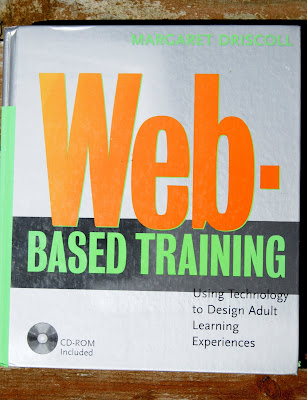
Web-Based Training (WBT) (2000)
Margaret Driscoll
I bought this book in 2001. Nearly a decade on I am delighted how apt it remains, even if the term may now have been superseded by e-learning - while cyberlearning had currency for a few years too and before this we had 'interactive learning'.
Even a decade on I recommend the book.
Training and learning are in different camps, one supposing a component of applied engagement (health and safety, fixing photocopiers, burying uranium trioxide, driving a delivery van, making cars, selling phones, employee induction) while the other is essentially cognitive (though with its physicality in this kind of prestidigitation).
Yet we made ‘training programmes’ on things like cognitive behavioural therapy. Corporate and government clients had the money to do these things.
Driscoll’s definition of WBT is somewhat longer than Weller’s definition (2007) of e-learning (electronically enhanced learning with a large component of engagement on the Internet). A bit ‘wishy-washy’ my exacting Geography A’ Level teacher would have said.
Hardly a clear definition if it has a let out clause. But when was anything clear about what e-learning is or is not, or should be? The term remains a pig in a poke; its most redeeming factor being that it is a word, not a sentence, and fits that cluster of words that includes e-mail.
Web-based training Driscoll (2000) says should be:
- Interactive
- Non-linear
- Easy to use graphic interface
- Structured lessons
- Effective use of multimedia
- Attention to educational details
- Attention to technical details
- Learner control
I like that. I can apply it in 2011. I did.
I was reading ‘Web-Based Training’ (and using the accompanying CD-rom) in 2001 and then active in the development of learning, or knowledge distribution and communication websites for the NHS, FT Knowledge ... and best of all, Ragdoll, the home of Pob, Rosie and Jim, Teletubbies and the addictive pleasures of ‘The Night Garden.’
We may call ourselves students, mature students even, or simply post-graduates, but would we call ourselves ‘Adult Learners.’
It’s never a way I would have defined my clients, or rather their audiences/colleagues, when developing learning materials for them in the 1980s and 1990s. Too often they were defined as ‘stakeholders,’ just as well I saw them as people and wrote scripts per-the-script, as if for only one person.
That worked, producing for an umbrella term does not.
Adult Learning doesn’t conjure up innovative e-learning, perhaps because of the connotations Adult Learning has inelation to the catalogue of F.E. courses then comes through the door every July or August.
This definition of an ‘adult learner’ would apply to everyone doing an OU course surely?
The special characteristics of adult learners Driscoll (2000:14)
- Have real-life experience
- Prefer problem-centred learning
- Are continuous learners
- Have varied learning styles
- Have responsibilities beyond the training situation
- Expect learning to be meaningful
- Prefer to manage their own learning
With some of these definitions baring more weight than others, don’t you think?
REFERENCE
And additional references used by Driscoll but not cited above:
References (Adult Learning)
Knowles (1994) Andragogy in action. Applying modern principles of adult learning.
Brookfield (1991) Understanding and facilitating adult learning
Cross (1992) Adults as learns: increasing participation and facilitating learning.
Freire (1970) A cultural action for freedom
Merriam and Caffarella (1991) Learning in adulthood
Kidd (1973) How adults learn